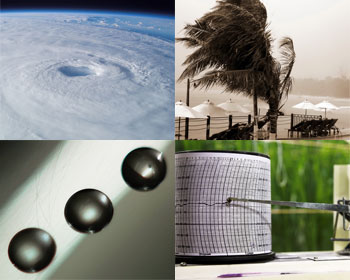A Publication of the
Applied Math and Science Education Repository

The AMSER Science Reader Monthly aims to provide educators with a useful package of information about a particular topic related to applied math and science by combining freely available articles from popular journals with curriculum, learning objects, and web sites from the AMSER portal. The AMSER Science Reader Monthly is free to use in the classroom and educators are encouraged to contact AMSER with suggestions for upcoming issues or comments and concerns at [email protected].
This month's AMSER Science Reader Monthly topic is Weather Manipulation.
Harnessing the Weather
Article
by Donovan Webster
Synopsis and resource annotations by Max Grinnell

The idea that humans can modify the weather to bring rain, alter the routes of hurricanes, and other seemingly impossible tasks, is as old as human civilization itself. Throughout history, different groups have believed that these types of weather modifications could change the course of empire, affect agricultural production, or potentially save lives.
This article by Donovan Webster from Discover magazine takes a close look at some recent innovations and experiments in weather modification. The piece begins by discussing the recent cloud seeding work done by the North American Weather Consultants group in Utah. Cloud seeding is a technique that involves using silver iodide in order to allow tiny water droplets to coalesce until they are big enough to fall out of the sky. Webster goes on to discuss the increasing interest in such experiments as of late, especially as public policy groups and governments grow concerned in the wake of phenomena like the 2007 summer floods in Great Britain, the 2005 hurricane season, and other similar weather events.
Moving along, the article provides a brief history of weather modification from the time of Leonardo da Vinci's experiments using cannonballs to stop hail to more recent endeavors such as the U.S. military project "StormFury". This project's goal was to weaken hurricanes by seeding their upper reaches with silver iodide crystals that would increase the amount of ice swirling around in the storm. As the water became ice, it would release heat, and this heat would effectively widen the eye of the storm and subsequently decrease the strength of its winds.
The next section profiles the work of Richard Blair, who is the CEO of Barken Fog Ops, which is a fog-abatement company in Salt Lake City. Barken Fog Ops works to control and remove the cold fogs at Salt Lake City International airport. His work has been tremendously successful, even if it occasionally also creates snowstorms.
The piece concludes by offering commentary from experts at the University of Virginia and the Hebrew University of Jerusalem on the ideas and current work surrounding hurricane moderation. While most of the experts seem to agree that computer modeling programs indicate that some type of programs are theoretically feasible, there also remains the distinct possibility of a very real human threat: pending litigation if the weather modification program is (or is not) effective.
Found below is a list of useful resources that will illuminate and enhance understanding of the topics found within this article. The first link will take visitors to a neat site from HowStuffWorks that provides some background details about how China has been working on a variety of cloud seeding projects. The second link leads to a great site from the Oklahoma Weather Modification Program that is designed to help students initiate a debate on the controversy surrounding the issue of inducing or enhancing precipitation. Moving along, the third link leads to an exercise created by Chris Fox at Kennesaw State University designed to introduce students to the idea that human activities can alter the chemistry or gaseous composition of the atmosphere. The fourth link leads to an excellent online exhibit created by the American Museum of Natural History to provide interested parties with charts, photographs, and graphs that discuss climate change. The fifth link will whisk interested parties to the homepage of the National Hurricane Center. Here they can take advantage of hazardous weather updates, and also look up historical data and forecasts. The last link will take users to a NASA website which provides some fundamental information about how hurricanes form, intensify, and then weaken.

![How Humans Change the Atmosphere [pdf]](https://amser.org/ImageStorage/Thumbnails/Thumb--00002259.png)


